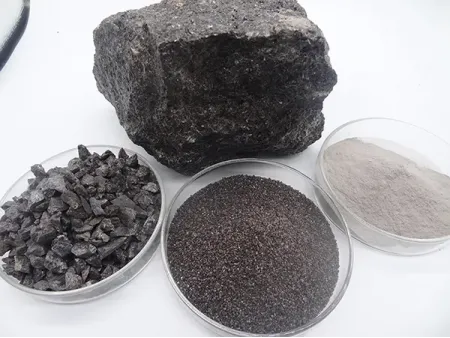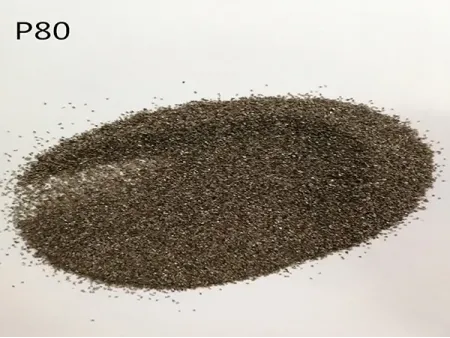Brown Fused Alumina
Brown fused alumina is produced by melting high-quality bauxite, iron filings, and anthracite in an electric arc furnace at high temperatures. The material is then crushed, shaped in a self-grinding machine, iron is removed by magnetic separation, and it is screened into various sizes. The main chemical component is Al2O3, with a content of 94%-96%, along with small amounts of Fe, Si, and Ti. It has a dense texture, high hardness, and is brown in color with great toughness. Brown fused alumina is suitable for manufacturing ceramic and resin high-bond abrasives, as well as for grinding, polishing, sandblasting, precision casting, and refractory materials.
Typical Chemical Analysis
| Applications | Standard Sizes | Chemical Composition (%) | Magnetic Content (%) | ||||
| Al2O3 | Fe2O3 | SiO2 | TiO2 | ||||
| Abrasives | F | 8#-80# | ≥95 | ≤0.5 | ≤1.5 | ≤3.0 | ≤0.05 |
| 90#-150# | ≥94 | ≤0.03 | |||||
| 180#-240# | ≥93 | ≤1 | ≤2 | ≤4 | ≤0.02 | ||
| P | 8#-80# | ≥95 | ≤0.5 | ≤1.5 | ≤3.0 | ≤0.05 | |
| 100#-150# | ≥94 | ≤0.03 | |||||
| 180#-220# | ≥93 | ≤1 | ≤2 | ≤4 | ≤0.02 | ||
| P280-P800 | ≥92 | ≤0.5 | ≤1.8 | ≤4.0 | - | ||
| W | W63-W7 | ≥92 | ≤0.5 | ≤1.8 | ≤4.0 | ||
| Refractories | Fraction | 0-1mm 1-3mm 3-5mm 5-8mm | ≥95 | ≤0.5 | ≤1.5 | ≤3.0 | - |
| Fine Powder | 200-0 320-0 | ≥92.0 | ≤1 | ≤2 | ≤4 | - | |
Typical Physical Properties
| Color | Brown |
| Cyrstal Form | Trigonal system |
| Specific Gravity | 3.95 |
| Bulk Density | 1.53-1.99g/cm3 |
| Mohs Hardness | ≥9 |
| Melting Point | 2200℃ |
| Maximum Use Temperature | 1850℃ |
| True Density | ≥3.60g/cm3 |
Differences Between P-Grit and F-Grit Brown Fused Alumina
-
F-grit is employed in bonded abrasives, featuring granular or gem-like particle shapes with high packing density.
-
P-grit is primarily utilized in coated abrasives, characterized by angular needle-like particle shapes, relatively lower packing density, and a more concentrated particle size distribution.
Applications
| Segment grain | Utilized in various applications such as unshaped refractory materials, shaped refractory materials, casting materials, refractory materials for ladles, and series of combined bricks for blast furnaces and hot blast stoves. Also employed in high-alumina bricks, carbon-containing materials, mullite bricks, gunning mix, ceramic cups, clay bricks, composite bricks, corundum products, furnace materials, refractory brick raw materials, and abrasive raw materials for steel plants, foundries, and high-end refractory materials for glass factories. |
| Fine powders | |
| Grit size | 1. Used for sandblasting and grinding of metal and non-metal products. 2. Applied in building ceramics, special ceramics, and craft ceramics. 3. Utilized in coarse grinding and high-pressure cutting, wear-resistant products, and as additives. 4. Used as raw materials in the production of resin abrasives and coated abrasives, such as sandpaper and abrasive cloth. 5. Employed as filtration media. 6. It functions as filler in automotive brake parts, special tires, and special construction products. It can also be used for constructing highway pavements, airport runways, docks, parking lots, industrial floors, and sports grounds as wear-resistant materials. 7. Used in abrasive water jet cutting. |
| Micro powder | Used in bonded abrasives, coated abrasives, as well as in floor/wall laminates for polishing, grinding, ceramics, and tiles. |
Production Flow
Raw material selection → crushing → grinding → mixing and forming → high-temperature smelting → cooling and crushing → screening and packaging
- Raw material: Bauxite
- coarse crushing
- High-temperature smelting
- Ball milling
- Magnetic separation and screening
- Weighing and packaging




